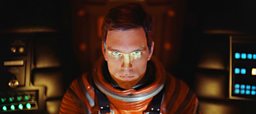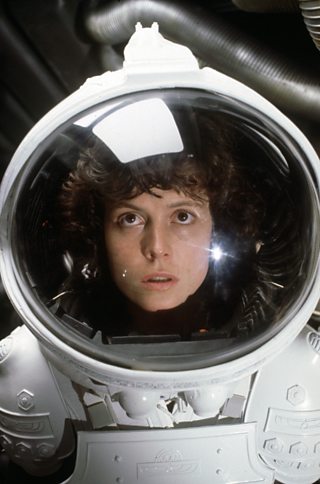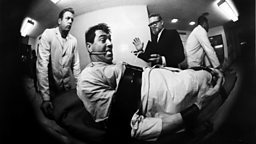Fearful visions: The troubled futures of sci-fi cinema
21 November 2014
Sci-fi cinema encourages us to imagine the future. For 大象传媒 Science Fiction Season, Film 2014's explains how they reveal our deepest insecurities about what lies ahead.

In 1999, Steven Spielberg booked a number of rooms at Shutters Hotel in Santa Monica, California. There, he gathered together a team of scientists, urban planners and professional innovators.
Their goal was to discuss what the year 2054 might really look like; the results of their weekend brainstorm would find their way into Spielberg’s futuristic thriller Minority Report. If the purpose of sci-fi movies were to be a crystal ball, then Spielberg’s film might be the greatest of them all.
Its foresight was uncanny. Minority Report, based on a story by Philip K Dick, brimmed with things to come that duly came: gesture control of computers, personalised advertising, police use of “predictive analytics” to stop crime. Yet while a very good film, it stands in the shadow of others whose actual science was altogether shakier. Big screen sci-fi has given us visions beyond our imagination – but fortune-telling is only part of the point.
“What’s it about?” would-be screenwriters are advised to ask of their stories, but that’s just the first half of the question. The second is more important: “What’s it really about?” It could be the caption for the whole history of sci-fi cinema, the answers changing from film to film like a news-ticker running along the bottom of the screen.
The story of big screen science fiction starts with a bright bang of optimism. The first chapter was A Trip To The Moon, a tale of lunar conquest in which cinema pioneer Georges Méliès channelled the spirit of Jules Verne. Méliès made his film in 1902, a year before Orville Wright got a plane into the air for 20 seconds – his gleeful rocketship adventure has the innocence of pure fantasy.
Related Links
-
![]()
Weekly film news and reviews, co-presented by Danny Leigh.
But later, as we closed on the heavens, reality turned the mood more gloomy. After the actual moon landings of 1969, space would usually be portrayed as a tundra of frozen nothingness with the occasional looming health-and-safety disaster. For all the mystic grandeur of Stanley Kubrick’s 2001: A Space Odyssey, the definitive space sci-fi remains the rather more fleshy Alien. All our brilliance, the film suggested, just puts us in the way of sharper teeth – and its success proved science can’t stop us being frightened of the dark.

But were we safer back on Earth? As the 20th century sped on in a mad dash of technological advancement, the loss of so much that was familiar could hardly fail to unnerve us. And what better outlet for our panic than the movie – the most technologically advanced of art forms? Outwardly, we gasped with joy at each shiny new wonder fresh from the lab – on screen, our subconscious admitted the pace of change was making us dizzy.
By the time Fritz Lang directed Metropolis in 1927, World War One had already laid bare technology’s dark side – and the idea that science would inspire a new age of peace and equality was done for. Lang’s villain was the fiendish inventor Rotwang, but soon those old reprobates Henry Jekyll and Victor Frankenstein would jump from page to screen to cement the fact that in sci-fi movies there are no scientists – only mad ones.
Unsurprising, then, that their work would make us so uneasy. Though it was the uniquely scarred post-war Japanese psyche that raised up Godzilla, sci-fi everywhere brimmed with dire warnings about the atomic age. Computers spooked us since long before 2001’s Hal 9000 went rogue. Robots were never entirely welcome, probably the most telling image in all sci-fi the human face half-torn away to reveal a mess of circuitry in Westworld and The Terminator.
Gaze into that spaghetti of wires and you glimpse one of sci-fi’s deepest anxieties – that progress will cost us our humanity. Let too much reason into our lives and we risk losing what makes us people; with every giant leap for mankind comes a new threat to our free will.
But the funny thing with sci-fi is that we get pretty much exactly what’s coming to us. Trouble starts because we’ve asked for it trying to play God – or because we’re violent, amoral monsters. It’s one of the paradoxes of movie sci-fi that while fretting over our fate, so many films paint us as a species you wouldn’t want to get stuck in a lift with. “Beware the beast Man, for he is the Devil’s pawn,” said the apes’ sacred scrolls in Planet of the Apes, and with their streak of self-loathing, plenty of sci-fi movies would agree.

Now poetic justice arrives in the form of endless dystopias. In old-fashioned examples of the genre, there was at least the occasional jetpack to lighten the mood. Lately, the future on film is invariably ruined, as if all the articles we can’t bring ourselves to read about climate change end up taking their revenge by ambushing us on screen.
Most recently, a scorched Earth awaits us in Christopher Nolan’s Interstellar, a movie not only concerned with space, but time. Of course, back when Méliès was making films, time travel seemed just another hurdle that mankind would eventually stride over. Unhindered by reality, his descendants have been able to bend and stretch time into some of sci-fi’s true masterpieces, films where the new looks like a Greatest Hits of the old (Blade Runner), or envoys from the future travel back into the past to save them both (the vastly influential French short La Jetée).
With the moon old hat and space full of satellites, what lies ahead is the last unknown – and time is the one deal we can’t get out of. We need ghost stories because we don’t know what happens to us when we’re no longer here. We need science-fiction because we don’t know what happens to here without us.

Danny's sci-fi top six
LA JETÉE (1963)
Director Chris Marker’s heartbreaking film is a story of love, time travel and the end of the world. Set in Paris and made up entirely of still photographs, its plot was later recycled by Hollywood for Twelve Monkeys.
SECONDS (1966)
There are times when a new identity surely appeals to us all. Rock Hudson is the “reborn” struggling to embrace his chance to start over in a Twilight Zone-inflected black-and-white classic with an acid view of 60s culture.
REPO MAN (1984)
A glorious marriage of 50s B-movie and the punk rock chaos of early 80s LA. Repo Man fuses conspiracy theories, alien visitations and a stolen car with a secret to create a timelessly deadpan sci-fi satire.
STALKER (1979)
After his masterpiece Solaris Andrei Tarkovsky made Stalker, perhaps even greater. Two men and their guide journey into "the Zone", an unearthly stretch of beauty and desolation where your desires can be fulfilled.
INVASION OF THE BODY SNATCHERS (1956)
Alternately claimed as anti-communist propaganda and a dire warning of the dangers of anti-communism, little else comes close to matching the mood of creeping dread in this, the original version of Humanity versus Pod People.
UNDER THE SKIN (2013)
Proof that sci-fi hasn’t lost its ability to unnerve. Jonathan Glazer set out to make a film about an alien at large in Scotland that left the audience feeling alien ourselves. It worked. A jolt to the senses, impossible to forget.

